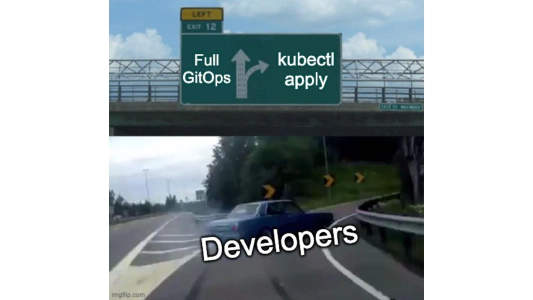Continuous Integration and Continuous Delivery (CI/CD) has become an indispensable cornerstone of modern software development, enabling teams to automate the build, test, and deployment processes. However, the traditional CI/CD pipeline, where a single system orchestrates both building and deploying, can become a bottleneck, especially in complex, cloud-native environments. This article examines the limitations of this monolithic approach and introduces a more robust and scalable alternative: separating the CI process from the CD process and leveraging GitOps principles. We’ll delve into the benefits of this evolved strategy, including improved resource utilization, enhanced rollback capabilities, a declarative approach that aligns with modern infrastructure, and enhanced security.
Limitations of Traditional CI/CD

In the early days of CI/CD, infrastructure management was often treated as a separate concern, handled through configuration management tools like Ansible, Puppet, Chef, or even ad-hoc scripts. Changes were frequently applied on demand, leading to configuration drift, inconsistencies across environments, and the ever-present need for hotfixes to address unexpected issues. Even with the adoption of DevOps practices and cross-functional teams, a clear separation between development and operations often persisted, creating communication silos and hindering agility.
The CI/CD pipeline itself, often a single monolithic entity responsible for both building and deploying, became a central point of complexity, incorporating custom logic and following an imperative approach. While the CI stage typically handled testing, building artifacts, and creating container images, the CD stage often involved automated deployments to non-production environments followed by manual approvals for production deployments. This hybrid approach, while offering some improvements over manual processes, ultimately falls short in addressing the challenges of modern, cloud-native architectures.
The classical CI/CD pipeline approach, which tightly couples building and deploying into one automated flow, exhibits several critical shortcomings that limit scalability, reliability, and security:
- Difficult and Often Incomplete Rollbacks: Traditional CD pipelines often construct deployment manifests “on the fly” using scripts or templating engines, and immediately deploy them to clusters. This makes rollbacks complex and incomplete, as there’s no complete audit trail of the precise deployment process. Often, the manifests themselves are not versioned, making true rollback impossible without significant manual intervention and a deep understanding of the system’s history.
- Tight Coupling and Reduced Flexibility: The tight coupling between building and deploying reduces flexibility and increases complexity. Changes to the deployment process (e.g., adding a new deployment strategy, modifying resource limits) often require modifications to the CI pipeline, and vice versa. This interdependency increases the risk of unintended consequences and hinders the ability to iterate quickly on both the application and the deployment process.
- The Imperative vs. Declarative Conflict: Employing an imperative approach to manage declarative systems like Kubernetes (or other Infrastructure-as-Code tools like Terraform/OpenTofu) is inherently problematic. Why manage a system whose core philosophy is based on desired state with sequences of commands? This leads to inconsistencies, difficulties in tracking changes, and increased complexity in troubleshooting issues.
- Deployment Disconnect and Lack of Unified Management: Deployments are often treated as separate events, disconnected from platform changes. However, in reality, the platform exists to serve the application, and changes in one often necessitate changes in the other. Consider explicit versioning of platform components alongside application code. A unified approach to managing both application deployments and platform changes – ideally through GitOps – greatly simplifies operations, diagnostics, and rollbacks, providing a holistic view of the system’s state.
- Limited Auditability and Security Risks: Traditional CI/CD pipelines often lack robust audit trails, making it difficult to track who made what changes and when. This can create security vulnerabilities, especially if sensitive credentials or configuration parameters are embedded directly within the pipeline scripts. Without a clear audit trail, it becomes challenging to detect and respond to malicious activity or unauthorized changes.
- Resource Contention and Scalability Issues: A monolithic CI/CD pipeline can become a resource bottleneck, especially when handling multiple concurrent builds and deployments. This can lead to increased build times, delayed deployments, and overall reduced agility. Furthermore, scaling the pipeline to handle increased workload often requires significant investment in infrastructure and operational overhead.
Embracing Separation and GitOps: A New Paradigm for CI/CD

To overcome the limitations of traditional CI/CD, we can decouple the build and deployment processes, creating a more scalable, resilient, and secure system. This involves embracing GitOps principles to manage the deployment process in a declarative and auditable manner.
Here’s a breakdown of this evolved approach:
- Dedicated CI for Building and Artifact Creation: Leverage your existing CI engine (e.g., Jenkins, GitHub Actions, GitLab CI) to focus solely on building, testing, and creating artifacts. This includes compiling code, running unit tests, performing integration tests, building container images, generating deployment manifests, and creating release packages. The CI process should produce well-defined, immutable artifacts that are ready to be deployed.
- GitOps-Powered CD for Declarative Deployment Management: This is where the real transformation occurs. Define the desired state of your applications declaratively in a Git repository (or a set of repositories). This repository becomes the single source of truth for your application deployments, specifying the desired version of each application, the target environment, the resource limits, the configuration parameters, and any other relevant deployment settings.
- The GitOps Engine: Automating Synchronization and Enforcement: Employ a GitOps engine (e.g., Argo CD, Flux CD) to automatically synchronize the desired state defined in the Git repository with the actual state of your environment. The GitOps engine continuously monitors the Git repository for changes and automatically applies those changes to your environment, ensuring that the actual state always matches the desired state.
- Unified Management and Holistic Visibility: Integrate the management of application deployments with platform changes. Because some platform changes depend on application changes (e.g., through explicit versioning of platform components, shared libraries, or API contracts), managing them together simplifies operations, diagnostics, and rollbacks, providing a holistic view of the system’s state. This unified management approach reduces the risk of inconsistencies and ensures that changes are applied in a coordinated and predictable manner.
Who Stands to Benefit the Most? Identifying the Ideal Candidates
While the benefits of this separated CI/CD and GitOps approach are significant for many organizations, the magnitude of these benefits tends to correlate with the complexity and scale of their operations.
- Large, Complex Organizations: The biggest gains will be realized by large organizations with numerous complex projects, multiple teams and departments, and dozens (if not hundreds) of applications. The increased control, auditability, and consistency that GitOps provides are invaluable when managing deployments at scale. These features help to streamline operations, reduce the risk of errors, and improve overall security.
- Startups with Greenfield Projects: This approach is also highly beneficial for startups with greenfield projects. By adopting a GitOps-based deployment strategy from the outset, they can establish a scalable and reliable deployment process from the ground up. This helps them to reduce technical debt, accelerate innovation, and grow faster.
Quantifiable Benefits of the New Approach
Adopting a separated CI/CD approach with GitOps delivers a wide range of tangible benefits:
- Accelerated Time to Market: Faster release cycles and reduced Time To Market (TTM) are crucial for maintaining a competitive edge. By automating the deployment process and eliminating manual steps, GitOps enables teams to deliver new features and bug fixes more quickly and efficiently.
- Enhanced Transparency and Auditability: Every change is tracked in Git, providing a clear and comprehensive audit trail of all deployments. This improved visibility makes it easier to track down problems, identify security vulnerabilities, and comply with regulatory requirements.
- Simplified and Complete Rollbacks: Reverting to a previous state is as simple as reverting the corresponding commit in the Git repository and allowing the GitOps engine to automatically synchronize the changes. This eliminates the complexity and risk associated with manual rollbacks, ensuring that the system can be quickly and reliably restored to a known good state.
- Everything as Code and Infrastructure as Code: The GitOps approach fully supports the “Everything as Code” (EaC) philosophy, preventing the chaos and inconsistencies that traditional CI/CD pipelines can introduce. By treating infrastructure, configurations, and deployment manifests as code, teams can automate and standardize the entire deployment process, ensuring consistency and repeatability across environments.
- Improved Security and Compliance: By managing all deployment configurations in Git, you gain improved control over access and permissions. Git’s built-in version control and audit logging provide a strong foundation for security and compliance. Furthermore, by integrating security checks into the CI pipeline, you can identify and address potential vulnerabilities before they reach production.
- Enhanced Collaboration and Reduced Errors: The declarative nature of GitOps promotes collaboration and reduces the risk of human error. By expressing the desired state of the system in code, developers and operations teams can work together more effectively to define and enforce consistent deployment policies.
- Scalability and Resiliency: By decoupling the CI and CD processes, you can scale each component independently to meet changing demands. This ensures that your deployment pipeline remains responsive and resilient, even under heavy load.
Practical Steps for Adopting CI & GitOps
Implementing CI & GitOps may seem daunting at first, but the process is surprisingly straightforward when broken down into manageable steps:
- Select a Git Provider: Choose a Git provider (e.g., GitHub, GitLab, Bitbucket) that meets your security and collaboration needs. Establish a clear repository structure, including a dedicated “source of truth” repository (or set of repositories) for GitOps-managed deployments. Carefully consider repository access control to limit who can modify the infrastructure.
- Configure Your CI Pipeline: Modify your existing CI engine (e.g., Jenkins, GitHub Actions, GitLab CI) to focus on building container images, running tests, and generating deployment manifests. The CI pipeline should not directly deploy anything to your environment. Instead, it should commit the generated manifests to the GitOps repository. Ideally, the CI pipeline should not only create commits but also create new branches and automatically generate pull requests for those changes.
- Integrate a GitOps Engine: Choose a GitOps engine that aligns with your needs and connect it to your GitOps repository. Argo CD is a popular and powerful solution for many use cases, offering a wide range of features and integrations. Flux CD is a lightweight alternative that is well-suited for smaller environments or when you need a more streamlined solution. Configure the GitOps engine to automatically synchronize the desired state defined in the Git repository with your environment.
- Define Deployment Policies: Establish clear deployment policies and procedures that are enforced through the GitOps engine. This includes defining deployment strategies (e.g., rolling updates, blue/green deployments, canary releases), resource limits, security policies, and monitoring thresholds. These policies should be expressed as code and versioned in Git.
- Automate Validation and Testing: Integrate automated validation and testing into your CI/CD pipeline to ensure that changes are thoroughly tested before they are deployed to production. This includes running unit tests, integration tests, end-to-end tests, and security scans. You can also use tools like Open Policy Agent (OPA) to enforce custom policies and prevent deployments that violate those policies.
- Monitor and Observe Your System: Implement robust monitoring and observability practices to gain insights into the performance and health of your applications. Use tools like Prometheus, Grafana, and OpenTelemetry to collect and analyze metrics, logs, and traces. Set up alerts to notify you of any issues that require attention.
Is GitOps Implementation Effortless?
While adopting this approach may present initial challenges, the long-term benefits – reduced operational overhead, increased reliability, faster TTM, and improved security – make the investment worthwhile. The initial investment includes selecting the right tools, adapting deployment processes, and training staff. Experienced teams, particularly those already familiar with Infrastructure as Code and declarative configuration management, will find the transition easier to manage. Ultimately, GitOps is essential for teams looking to avoid the constant frustration and inconsistency often associated with traditional environments.
Conclusion: Embracing the Future of CI/CD with Separation and GitOps
By separating the CI and CD processes and embracing GitOps principles, organizations can overcome the limitations of traditional CI/CD and achieve a more scalable, reliable, and auditable deployment pipeline. This evolved approach aligns perfectly with the principles of Cloud Native development and enables teams to deliver software faster, more efficiently, and with greater confidence. It’s a journey worth undertaking, leading to a more robust, secure, and agile software delivery process.






Comments